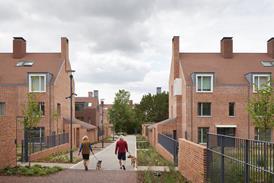Future of CPD ‘cannot be designed in an ivory tower’
The Arb has launched a major consultation exercise to shape its approach to the new system of monitoring architects’ continuing professional development.
The move is a response to greater powers which the Building Safety Bill will hand to the Architects Registration Board to censure architects who cannot demonstrate the required competences introduced as a result of the Grenfell fire and other disasters.
Arb’s chair, Alan Kershaw, said the new CPD regime cannot be designed in an ivory tower.

He encouraged all architects, and everyone working in the built environment, to read and comment on the principles before they are used to set up the new system.
These are:
:: Improve the overall competence of the profession: The scheme will aim for an overall positive shift in the collective competence of the profession by promoting a culture of continuing professional development. It will not be about catching out individuals.
:: Tailored by architects to their own practice and needs: The scheme will encourage architects to reflect, plan, act and evaluate on their learning activities in a way that is relevant to their practice and development needs. The approach will not be ‘one-size-fits-all’.
:: Proportionate and deliverable: Arb’s research shows the majority (70%) of architects are already committed to carrying out dedicated CPD annually, so the scheme will aim to formalise and shape that learning. It should, as far as possible, avoid additional costs for architects.
:: Avoid duplication where possible: Arb intends to design a model that is suitable for all architects, and will be considering how best it can work alongside other schemes – both in terms of subject matter and logistical compatibility.
In a paper published as part of the consultation, the Arb said: “The Building Safety Bill currently progressing through Parliament will, once it becomes an act, provide Arb with powers to monitor the ongoing competence of architects.

“We want to introduce a scheme that supports and encourages good practice, helps to raise competence within the profession, and can be tailored by each architect to their own practice and needs… They should be able to view the time they spend on it as an investment in their development.”
The paper added: ”Attending a course is just one example of CPD. There are many other activities that can contribute to a professional’s development – some planned, some unplanned. CPD can be acquired unexpectedly through a new experience or learning opportunity as much as it can from a peer review (including feedback from a colleague or client) or identifying a particular training need and addressing it.”
The Arb’s consultation was launched in the same week as the government announced a call for evidence from architects over the future of the entire regulatory system, including the future of Arb and how to improve diversity in the profession.
The new system is not expected to come into force before 2023, with the Building Safety Bill giving Arb the legal power to sanction architects who are “unable or unwilling” to meet the new requirements.
Kershaw said: “We’re focused on introducing an effective new scheme as soon as that is viable, but we’re equally determined to get it right.
>> Eleanor Jolliffe: On building safety, professional qualifications should count
>> Also read: All our Building Safety Bill coverage in one place
“We have lots of ideas but this isn’t something that can, or should, be designed in an ivory tower. If it’s going to improve standards of practice across the profession, architects need to help us design something they will use and find useful.”
The move was welcomed by Judith Hackitt who chaired the Independent Review of Building Regulations and Fire Safety which paved the way for the safety bill.
Arb’s policy paper setting out the principles is here, and the survey is here. It will close at midday on November 29.
















No comments yet